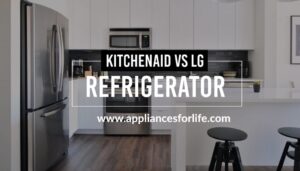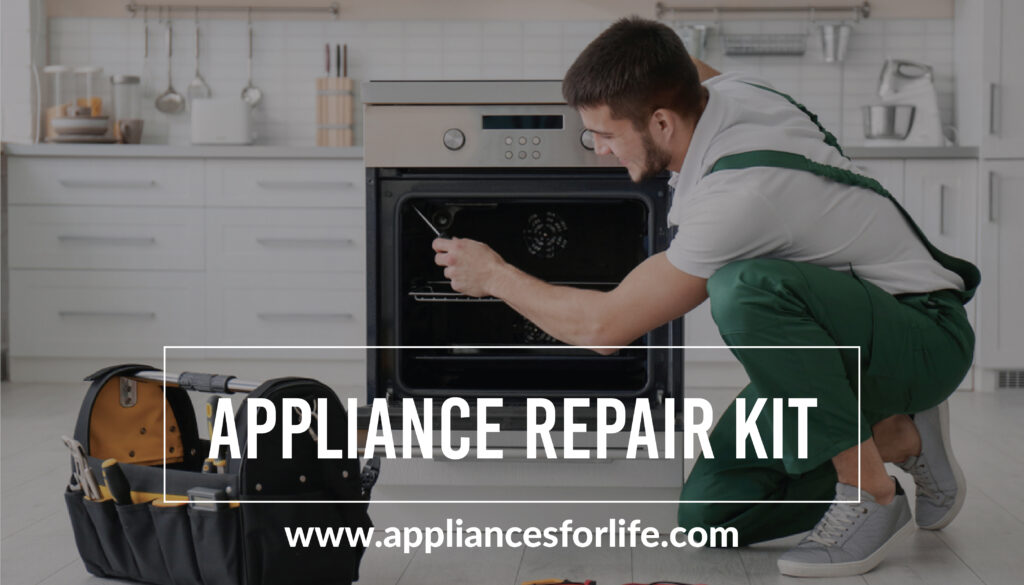- As long as you use your home appliances, they will experience necessary wear and tears. This wear and tear may eventually cause malfunctions that may endanger the proper functioning of the appliance. While it is necessary to get professional expertise to fix some of these faults, others can be properly fixed by yourself.
- If you have to carry out these repairs, you may need an appliance repair kit and follow some precautionary measures to guarantee safety while you do your repairs.
Small and Major Home Appliances Explained
Table of Contents
ToggleMost appliances that run in the home are electrical and connected to your home’s electrical system. These appliances operate using AC current from the circuit wiring in the home. When we speak of home appliance repairs, it is important to understand that home appliances have two main categories: major home appliances and small home appliances. Small appliances work on an estimated 110-120-volt circuits, and most times, the plugs on their cords have two blades. On the other hand, large or major appliances, such as washing machines, air conditioners, dryers, and ranges, usually require 220-240-volt wiring and cannot be operated on 110-120-volt circuits. The large appliances need to be connected to a grounded outlet using a grounded plug( a three-pronged device). This wiring prevents power surges that could overload your device or result in electrical shock. You can also inspect your appliances to find their power requirements- they are usually indicated in watts, volts, and sometimes amps.
On the flip side, small appliances are usually relatively simple machines. You will find them with simple elements like a fan, a set of blades, or rotating beaters attached to a drive shaft. Repairs for this home appliance category are quite simpler than those for large appliances- One major appliance like an air conditioner may have a thermostat, a refrigerator, a compressor, and a host of other seriously complicated wiring. From this, you can tell that its repairs will be relatively more complex. With this type of appliance, problems can occur in either the control devices or the mechanical/power components. Failure of a control device may affect one operation or the entire appliance; failure of a mechanical/power device usually affects only the functions that depend on that device. When a major appliance breaks down, knowing how to diagnose the problem is as important as knowing how to fix it.
Rules To Follow When Repairing Major Appliances.
There are mandatory rules to be followed when repairing a home appliance. These rules should never be taken for granted or ignored because failure to comply with one or all may cost you much more than what the breakdown already costs you. Note that these rules may be again mentioned when we get to the repairs of specific appliances and remember that the breakdown of a electrical device is innevitable, even if it is th best and made by the best home appliance brands.
Always disconnect or unplug your appliances from the power source. If your appliance works on gas supply, make sure to disconnect also from that source. If you turn the power on to check your work after repairing, do not touch the appliance; just turn the power on and observe. If adjustments are needed, turn the power off before you make them.
Pay attention to this; inspect your appliance to see if it is held together by screws, bolts, plugs, etc. In this case, there is hope for repairs. You can easily take its parts apart, but when you discover that your appliance is held together with rivets or welds, please do not attempt to repair the appliance yourself- You may need to get a professional for this one.
In most cases, broken or malfunctioning appliance parts can be replaced more quickly and inexpensively than they can be repaired by you or a professional. Replace any broken or malfunctioning parts with new parts made especially for that appliance. If you cannot find an exact replacement for the broken part, it’s okay to substitute a similar part as long as it fits into the old space. In this case, refer to the manufacturer’s instructions for installation.
Furthermore, it is important to procure the necessary appliance repair kit to carry out necessary repairs. Appliance parts are available from appliance service centers, appliance-repair dealers, and stores. While you do this, you should know that you do not have to go to a specific brand-name appliance parts center to obtain the parts and services you need for your brand-name appliances. Appliance failure could be a function of several factors- having to do repairs may not be wise if you are yet to explore other possible problem points. Lack of power is the most common cause of appliance failure. Before you start the testing and diagnosis process, take these preliminary steps:
Ensure that your appliance is properly plugged in. Also, check to see if the cord, the plug, and the outlet are working properly. You can use a voltage tester to confirm that the appliance works.
You may also go into your electrical system to ensure that the fuse or circuit breaker controlling the particular circuit where your appliance is plugged in still works fine. Check for blown fuses or tripped circuit breakers at the main and separate panels.
Check the owner’s manual for the appliance. Many manufacturers include helpful problem/solution troubleshooting charts. If you don’t have a manual for an appliance, you can probably get one from the manufacturer’s customer service department, even for an old or obsolete appliance.
How to repair Major appliances
Before you venture into repairing a major appliance, you should first disassemble it. All major appliances are not alike, but the method for separating them is almost the same. Remove the parts in reverse of the way the manufacturer put them together. You can also consult your owner’s manual for assembly diagrams and instructions. Bearing that, you will have to tighten those nuts again and put loosened parts back in place; note where each part and nut has been removed. If you are not so sure that you will be able to put the appliance back together, you can get your notepad nearby and make jottings or sketchings of your repair process. Do not forget to label all terminals and wires if you must disconnect more than one wire simultaneously.
To disassemble a major appliance, you need to begin with those knobs and fasteners you can see easily. Since many knobs are push-fit, you can easily unscrew them by simply pulling them off their control shafts. However, when these knobs are held in the case by setscrews or pins, gently detach the pins or setscrews however the case may be. All these fasteners are easy to release. Hence, you should have no problems at all removing the knobs.
Sometimes, appliance parts are held together by tabs, while others may just be force-fitted and hard to remove. In the case of the latter, do not force those parts apart, not to destroy them. Rather, look for hidden fasteners because most times, we think those parts are force-fitted while they are just held together by some hidden fasteners.
Fasteners may also be hidden under a nameplate or company logo, behind a scarcely visible plastic plug, a cork pad on the bottom of the appliance, or an attachment plate. Carefully pry up the part that is hiding the fastener. When you reassemble the appliance, snap the concealing part back over the fastener or, if necessary, glue it into place. If you can’t find hidden fasteners on force-fitted parts, warm the parts gently with a heating pad; the heat may make disassembly easier. Inside the appliance, watch for clips holding parts to the housing panel.
Now that it’s time to reassemble your appliance make sure to carefully vacuum inside the appliance to get rid of dust and other dirt particles that may be found. There may be other parts needing fixing or some adjustment or other. Look around for them before you put things back together. If the appliance has a motor, lubricate the motor. Check carbon brushes in universal motors for wear and replace them if necessary. Lubricate moving parts sparingly and make sure electrical contacts are clean. Apart from doing this properly, reassemble the appliance in reverse on the way it was taken apart, and remember never to force parts together. Make sure moving parts, such as armatures or gears, don’t bind. After reassembly, connect the power and turn it on. If it makes noise, smells, or overheats, turn it off and disconnect the power. Then go back over your repair.
How to repair small appliances
First and foremost, it is important to know that there are three separate groupings of small appliances. Small appliances like toasters, coffee makers, and microwave ovens heat things up. Still, others like food processors and vacuum cleaners move things- food processors chop ingredients supplied to them into bits by moving them. In the same vein, vacuum cleaners suck up dirt through movements. The third category of small appliances does both- an example is a hair dryer. Now we will look at these categories and how they can be fixed.
Heating Appliances
Heating appliances convert electrical energy into heat; a good example of a heating appliance is an electric baseboard heater. When a baseboard heater is left on even when you are not at home, it may result to some untoward damage. In most cases, the amount of electrical current supplied to a particular home appliance determines how much heat it generates. This heat, one uses to toast bread- in toasters, brew coffee- in coffee makers, and dry fabrics- in dryers. This heat is developed by passing a current through a special wire called an element. Since the element makes it difficult for electricity to pass through, some of its energy turns into heat. The electricity uses so much energy to overcome the resistance of a toaster element, for instance, that it glows bright red, thus toasting the bread.
Repairing Small Appliance Cords and Wires
It is necessary to test your appliance cord or wires but before you do this, connect from your electrical source. With the tester attached, move the wire to ensure no break in the strands that can cause intermittent shorts. Also, check the quality and pliability of the cord or wire insulation. If any breaks or cracks may eventually expose strands, replace the cord or wire with one of equivalent rating and gauge.
How to Fix Common Home Appliances
It’s a given that your household appliances can stop working at any time. To put this into perspective, even the quietest juicers will become noisy when they encounter some malfunction, they can even stop working and if there is no backup plan, it can be frustrating. Most faults come unexpectedly, making it almost impossible for you to reach out to a technician for assistance immediately. However, considering that not all faults need a technician’s intervention, solutions can be provided to these problems by fixing them yourself. Below are common problems with home appliances, and they can be fixed yourself.
Refrigerator leaking water
A refrigerator leaking water can be frustrating. It could even become really dangerous when it causes the kitchen floor to be wet and slippery. Therefore, to prevent accidents and potential damage to your refrigerator, ensure you inspect your refrigerator’s surroundings for any water puddles. Even the best french door refrigerators with water dispender, encounter this fault, look below to learn how to fix it.
What causes leaks and how to fix it
Improper Tilting
To keep the refrigerator’s coolant running properly, a refrigerator should never be level with the floor- Usually, a slight backward tilt will keep the refrigerant flowing as it should. This position is also great for making a refrigerator door swing shut automatically. The back of the fridge should be about ¼” to ½” closer to the floor than the front.
If you’ve recently moved your fridge or completed renovations, the unit might be tilted improperly or too close to level to drain correctly. You can check this easily enough with a spirit level placed on the top of the fridge, perpendicular to the doors. If the angle is out of line, follow these steps to correct it.
Detach the grille from the bottom front of the refrigerator
Use a crescent wrench to adjust the length of your refrigerator’s legs but do not remove the legs
Check your work against the spirit level until you get the angle right.
Damaged Drain Pan
Naturally, a fridge is supposed to leak some water, but the leaked water should collect in a pan under the refrigerator to prevent the floor from getting extremely wet. Although it’s unusual for this pan to develop holes or cracks, this can be one cause of a water leak. Here’s how to check for this problem and fix it.
- Remove the grille from the bottom of the refrigerator, again
- Locate the flat pan resting in the bottom of the refrigerator.
- Pull out the pan carefully as it may contain some water. Then, inspect it for any damage.
- If the pan is damaged, take it to the hardware store to purchase an identical one or visit the manufacturer’s website to find a replacement.
Blocked Defrost Drain
There is an opening in the bottom black wall located in the freezer compartment of your refrigerator. This space allows for humid air to escape, but if it happens to be blocked, the fridge condenser coils will have to work overtime and start dripping water. Here’s how to check for and solve this problem. Now, what you do is locate the defrost drain and do the following;
- Remove any frozen food items covering it. Create a clear path from the drain to the ceiling and wait a day to see whether this solves the problem.
- If you still see puddles, empty the freezer, unplug it, and remove the cap from the defrost drain.
- Fill a turkey baster with warm water and squirt it down the drain. This should unfreeze any clogs in the line, and you can plug the fridge back in to continue using it. You may need to empty the drain pan manually over the next few days.
- If no extra water comes out of the defrost drain from step 4, the clog may still be in place. Unplug the fridge, pull it away from the wall, and check the drain line manually. This line runs from the freezer to the underside of the fridge. Unclog it with a pipe cleaner or bottle brush.
Necessary Tools in an Appliance Repair Kit
- Slot and Philips Screwdrivers
A Philips head screwdriver is a common tool in almost every household. Most mounting screws inside and outside of an appliance, can be removed using this primary repair tool. That said, it is advisable to get a small variety of size, sharpness, and handle length depending on the depth and width of each screw – and how easy it is to reach. You can consult mone of the top appliance repair companies for this tool and it is guaranteed you’ll get the best quality.
- A Putty Knife
A putty knife is the second most used tool in repairs. A putty knife and slot screwdriver are often used for the same purpose. It can be used to seam in the appliance cabinet and release small clips holding the panels together.
- Combination Wrench Set
The next set of tools you’ll want is a rack of combination wrenches. These are not always listed on your mandatory tools list, but it’s extremely helpful to have the right wrench size when needed, both in open and socket ends. One rack of combination wrenches is always a smart addition to the appliance repair toolkit. When you don’t need them to open or close something, you may need them to brace a bolt while you work two sides of a problem.
FAQs
When Should I Call A Professional To Fix My Appliance?
It is given that home appliances will stop working or malfunction at some point, which is why it is necessary to brace up for the moment. Your Air Conditioner late at night makes it impracticable to get professional help. Hence, it can always help in this case to get a repair kit and look for DIY tips to help you fix your home appliance by yourself. If you can fix your appliance yourself, you may only need to call for professional assistance when it is a complex issue to be solved.
20 MINUTES
ESTIMATED TIME DESIGNING AND UPLOADING THIS ARTICLE
9 HOURS
ESTIMATED TIME RESEARCHING AND WRITING THIS ARTICLE
You Might Also Like

How to Use a GE Washing Machine?
There’s no talking about one of the most successful American appliances brands without mentioning GE because that’s where the brand belongs. GE has done a great job to keep the United States at the forefront of the production of the best household appliances in the

A Review of Crosley Professional Dishwashers
There once was a time when dishwashers were a luxury in the kitchen. No one really needed it except those who needed to wash dishes in a large quantity. But when it was discovered by many that dishwashers are easy to use, so easy that

Top 3 Most Affordable 36-inch Gas Ranges
The best gas ranges come at a cost, but on a market filled with so many options, getting your hands on affordable options might not be all that easy. In this article, we’re going to be looking at some of the most affordable 36-inch gas

Garage Air Conditioner To Keep You Cool
Garage Air Conditioner to Cool Your Garage and Beat the Heat Once the hot summer months come around, you will need different sources of cooling systems to keep the temperature low in your home. Shopping for your new garage air conditioner now could save you

KitchenAid and LG are two of the biggest appliance brands in the game. Both brands have played a huge game in the evolution of modern appliances. We can’t stress enough how competition in this kind of industry is always healthy, and many brands have been

Good Kitchen Appliance Brands For You
Starting Your Search Good kitchen appliance brands aren’t hard to find these days with the internet as prevalent as ever. You can buy anything and everything online! And of course, everyone requires kitchen appliances that are reliable and not too costly. It is better to be practical because hard-earned

The Best Airtight heater To Keep That Wicked Chill Away
An airtight heater is designed with carefully fitted seams, it comes with a door that seals tightly, and is equipped with an air inlet that controls the burn rate. This wood-burning airtight heater gives you simplicity and economy when heating small spaces such as hunters’

Where to Shop – Our Choice of Appliance Outlet Stores
Are you in need of appliances but don’t know where to shop? Do you need something simple like an under the counter microwave or something a little more complicated like an electric stovetop or a gas cooktop? If you do then don’t stress, we are

How to Install Ice Maker on LG Refrigerator?
LG is one of the best manufacturers of electronics and home appliances in the world, and for a while now, the brand has justified its position at the summit of the industry. The South Korean company has been a consistent figure in the industry for

How to Use a Nutribullet Blender
To help people maximize their Nutribullet blenders, we’ll be discussing how to use a Nutribullet blender. To help you understand your Nutribullet blender better, we’ll also be looking at the things that make up a high-powered blender like the Nutribullet. Many people are not investing

